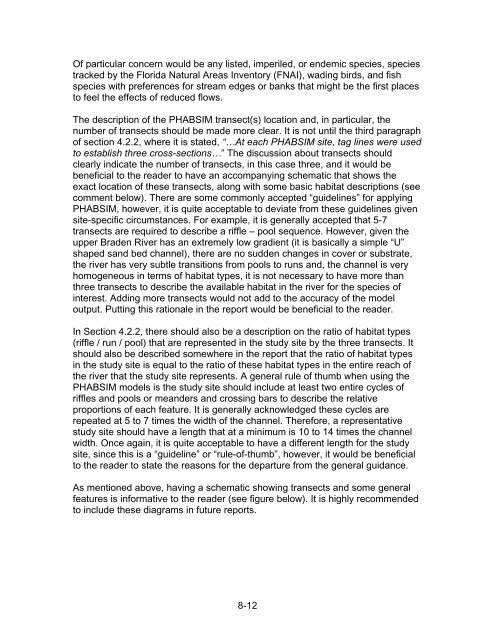Chapter 1 Minimum Flows and Levels - Southwest Florida Water ...
Chapter 1 Minimum Flows and Levels - Southwest Florida Water ...
Chapter 1 Minimum Flows and Levels - Southwest Florida Water ...
Create successful ePaper yourself
Turn your PDF publications into a flip-book with our unique Google optimized e-Paper software.
Of particular concern would be any listed, imperiled, or endemic species, species<br />
tracked by the <strong>Florida</strong> Natural Areas Inventory (FNAI), wading birds, <strong>and</strong> fish<br />
species with preferences for stream edges or banks that might be the first places<br />
to feel the effects of reduced flows.<br />
The description of the PHABSIM transect(s) location <strong>and</strong>, in particular, the<br />
number of transects should be made more clear. It is not until the third paragraph<br />
of section 4.2.2, where it is stated, “…At each PHABSIM site, tag lines were used<br />
to establish three cross-sections…” The discussion about transects should<br />
clearly indicate the number of transects, in this case three, <strong>and</strong> it would be<br />
beneficial to the reader to have an accompanying schematic that shows the<br />
exact location of these transects, along with some basic habitat descriptions (see<br />
comment below). There are some commonly accepted “guidelines” for applying<br />
PHABSIM, however, it is quite acceptable to deviate from these guidelines given<br />
site-specific circumstances. For example, it is generally accepted that 5-7<br />
transects are required to describe a riffle – pool sequence. However, given the<br />
upper Braden River has an extremely low gradient (it is basically a simple “U”<br />
shaped s<strong>and</strong> bed channel), there are no sudden changes in cover or substrate,<br />
the river has very subtle transitions from pools to runs <strong>and</strong>, the channel is very<br />
homogeneous in terms of habitat types, it is not necessary to have more than<br />
three transects to describe the available habitat in the river for the species of<br />
interest. Adding more transects would not add to the accuracy of the model<br />
output. Putting this rationale in the report would be beneficial to the reader.<br />
In Section 4.2.2, there should also be a description on the ratio of habitat types<br />
(riffle / run / pool) that are represented in the study site by the three transects. It<br />
should also be described somewhere in the report that the ratio of habitat types<br />
in the study site is equal to the ratio of these habitat types in the entire reach of<br />
the river that the study site represents. A general rule of thumb when using the<br />
PHABSIM models is the study site should include at least two entire cycles of<br />
riffles <strong>and</strong> pools or me<strong>and</strong>ers <strong>and</strong> crossing bars to describe the relative<br />
proportions of each feature. It is generally acknowledged these cycles are<br />
repeated at 5 to 7 times the width of the channel. Therefore, a representative<br />
study site should have a length that at a minimum is 10 to 14 times the channel<br />
width. Once again, it is quite acceptable to have a different length for the study<br />
site, since this is a “guideline” or “rule-of-thumb”, however, it would be beneficial<br />
to the reader to state the reasons for the departure from the general guidance.<br />
As mentioned above, having a schematic showing transects <strong>and</strong> some general<br />
features is informative to the reader (see figure below). It is highly recommended<br />
to include these diagrams in future reports.<br />
8-12
















